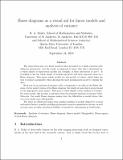Hasse diagrams as a visual aid for linear models and analysis of variance
Abstract
The expectation part of a linear model is often presented as a single equation with unknown parameters, and the reader is supposed to know that this is shorthand for a whole family of expectation models (for example, is there interaction or not?). It is helpful to list the whole family of models separately and then represent them on a Hasse diagram. This shows which models are sub-models of others, which helps the user to respect marginality when choosing the most parsimonious model to explain the data. Each row in an analysis-of-variance table corresponds to an edge in the Hasse diagram. In the scaled version of the Hasse diagram, the length of each edge is proportional to the appropriate mean square. This gives a visual display of the analysis of variance (ANOVA). For some people, this is easier to interpret than the standard analysis-of-variance table. Moreover, the scaled Hasse diagram makes clear the difficulties in model choice that can occur under non-orthogonality. The ideas are illustrated using some familiar families of models defined by crossed and nested factors, possibly including polynomial terms for quantitative factors, as well as some more recently introduced families of models for experiments in biodiversity.
Citation
Bailey , R A 2020 , ' Hasse diagrams as a visual aid for linear models and analysis of variance ' , Communications in Statistics: Theory and Methods , vol. 50 , no. 21 , pp. 5034-5067 . https://doi.org/10.1080/03610926.2019.1676443
Publication
Communications in Statistics: Theory and Methods
Status
Peer reviewed
ISSN
0361-0926Type
Journal article
Collections
Items in the St Andrews Research Repository are protected by copyright, with all rights reserved, unless otherwise indicated.

